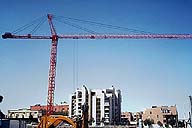
|
Image-GoddenF24
Typical crane structure. The vertical trussed tower of this crane is a good example of a long column unsupported at the top, fixed at the bottom, and subject to a variety of loadings, including torsion as the jib is turned.
|
|
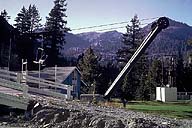
|
Image-GoddenF25
Ski lift. These posts at the end of a chair lift at a skiing center are inclined to match the resultant force of the cable on the top wheel. The top of the post is completely unsupported. (Squaw Valley, California)
|
|
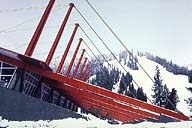
|
Image-GoddenF26
Cable-stayed roof (see also GoddenC71-C74). The steel posts are subjected to a large top loading from the cables. In the plane of the cables the posts are restrained from buckling by the cable connection, but transversely the posts are unsupported. The posts could have been braced together, but were not for aesthetic reasons. Under dead load the towers were prestressed backwards, so that they are straight under live load. (Squaw Valley, California)
|
|
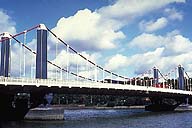
|
Image-GoddenF27
Chelsea Bridge over the River Thames. Suspension bridge towers are subjected to very heavy axial loading. Buckling has to be considered in the plane of the cables, and transversely. In the cable plane, tower can be considered pinned at top and pinned at the base. (London, England)
|
|
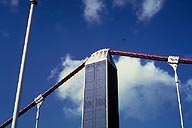
|
Image-GoddenF28
Top of the tower of the Chelsea Bridge showing the cable fixed to the saddle. The top of the tower is restrained by the cable in the plane of the cable, but is unrestrained transversely. (London, England)
|
|

|
Image-GoddenF29
Chelsea Bridge. Support at the base of the tower. In the plane of the cables the tower can rotate freely about the transverse direction the line of pin supports prevents rotation. This is a good example of a column with quite different boundary conditions about the two axes of buckling. (London, England)
|
|
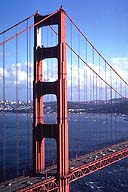
|
Image-GoddenF30
Golden Gate Bridge. This is the same basic problem as that of the Chelsea Bridge but on a much larger scale. Again the cables are fixed to saddles at the top of the towers, but the base of the column is fixed, not hinged. In the transverse direction, the two posts of the tower are connected by framing members which greatly increases the transverse stiffness. (San Francisco Bay Area)
|
|
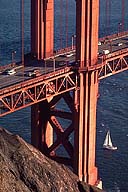
|
Image-GoddenF31
Bottom of the Golden Gate Bridge tower. In the transverse direction the two posts of the tower are heavily X-braced below road level, greatly increasing the transverse stiffness of the tower at road level. (San Francisco Bay Area)
|
|
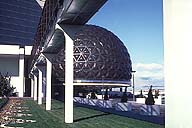
|
Image-GoddenF32
Unsupported columns, Caesar's Palace Hotel. These small concrete columns, supporting a moving walkway are effectively restrained in the direction of the walkway, but are unrestrained transversely at the top as all of the columns could displace in the same direction. (Las Vegas, Nevada)
|
|











